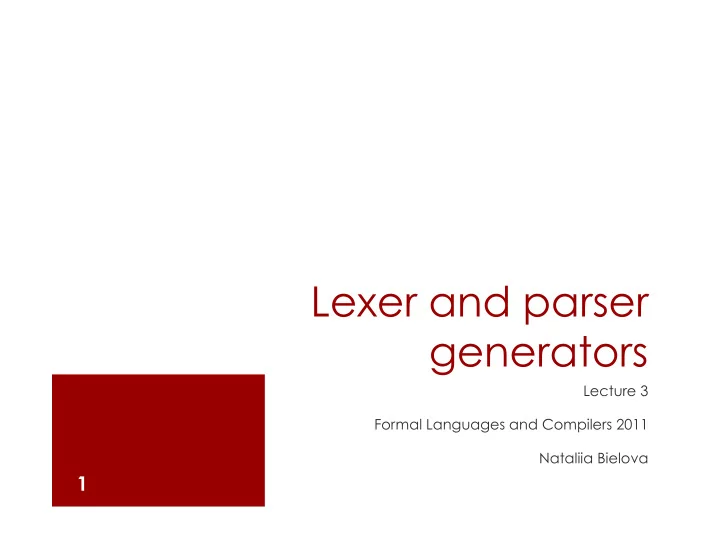

Lexer and parser generators Lecture 3 Formal Languages and Compilers 2011 Nataliia Bielova 1
2 Structure of a compiler Source Front-end Intermediate Back-end Executable code (analysis) Language (synthesis) code Formal languages and compilers 2011
3 Front-end structure Intermediate Language syntax IC tree tokens Source Parser IC generator C Lexer C generator code Front-end Back-end Formal languages and compilers 2011
4 Lexical analyzer (lexer) Input: program in source language Output: sequence of tokens (or error) Example: 17+3*2 → 17 + 3 * 2 Formal languages and compilers 2011
5 ocamllex Generator of lexical analyzer Input: “ semantic operations ” associate with regular expressions Output: lexer Invocation: ocamllex <myfile>.mll produces <myfile>.ml with the code of the lexer Formal languages and compilers 2011
6 Regular expressions ‘ a ’ simple character “ string ” string eof end of file _ (underscore) any character [ ‘ d ’ - ’ g ’ ‘ m ’ - ’ s ’ ] character set [^ ‘ a ’ - ’ c ‘ ‘ t ’ - ’ z ’ ] “ negated character set ” expr1 # expr2 difference (of two sets) expr* zero or more expr expr+ one or more expr expr? zero or one expr expr1 | expr2 either expr1 or expr2 expr1 expr2 expr1 followed by expr2 expr as ident bind the matched string to ident Formal languages and compilers 2011
7 Semantic operations Can contain any OCaml code which returns a value AND Utility of the library Lexing: Lexing.lexeme lexbuf string recognized by regexp Lexing.lexeme_char lexbuf n n-th character of the matched string Lexing.lexeme_start lexbuf position in which the matched string starts … Formal languages and compilers 2011
8 Example: calc_lexer.mll { open Calc_parser (* the type token is in the module calc_parser.mly *) exception Eof } let white_space = [' '] rule token = parse white_space { token lexbuf } (* skip the white space *) | ['\n'] { EOL } | ['0'-'9']+ as lxm { INT(int_of_string lxm ) } | '+' { PLUS } | '*' { TIMES } | eof { raise Eof } Formal languages and compilers 2011
9 Structure of the .mll file (* header section *) { header } (* definitions section *) let ident = regexp let ... (* rules section *) rule entrypoint [arg1... argn] = parse | pattern { action } | ... | pattern { action } and entrypoint [arg1... argn] = parse ... and ... (* trailer section *) { trailer } Formal languages and compilers 2011
10 Syntactical analyzer (parser) Input: sequence of tokens (from lexer) Output: parse tree (or syntax tree) Example: + * 17 + 3 * 2 → 17 3 2 Formal languages and compilers 2011
11 ocamlyacc Generator of syntactic analyzer ( Yet Another Compiler Compiler ) Input: semantic actions associate with context-free grammar Output: parser Invocation: ocamlyacc <myfile>.mly produces <myfile>.ml with the code of the parser Formal languages and compilers 2011
12 Grammar and semantic actions Context-free grammar: puts together terminal and non-terminal symbols e.g. expr PLUS expr Semantic action: Ocaml code that does the job Formal languages and compilers 2011
13 Structure of the .mly file % { header (OCaml code) % } declarations (%token, %type, ...)> %% rules (symbol {semantic action})> %% trailer (Ocaml code) Comments are enclosed between /* and */ (as in C) in the “ declarations ” and “ rules ” sections, and between (* and *) (as in Caml) in the “ header ” and “ trailer ” sections. Formal languages and compilers 2011
14 Declarations %token name … name /* terminal symbols */ %token < type > name … name /* terminal symbols of specific type*/ %start symbol … symbol /* nonterminal starting symbol,, for which type should be defined*/ %type < type > symbol … symbol /* declare type of nonterminal symbol */ %left symbol … symbol %right symbol … symbol %nonassoc symbol … symbol Formal languages and compilers 2011
15 Rules nonterminal : symbol … symbol { semantic-action } | … | symbol … symbol { semantic-action } ; Semantic actions are arbitrary Caml expressions can access the semantic attributes with the $ notation: expr PLUS expr { $1 + $3 } Formal languages and compilers 2011
16 Example: calc_parser.mly %token <int> INT %token PLUS TIMES %token EOL %left PLUS /* lower precedence */ %left TIMES /* higher precedence */ %start main %type <int> main %% main: expr EOL { $1 } ; expr: INT { $1 } | expr PLUS expr { $1 + $3 } | expr TIMES expr { $1 * $3 } ; ; Formal languages and compilers 2011
17 Calculator http://disi.unitn.it/~bielova/flc/exercises/03-Calculator.zip Definition of the lexer: calc_lexer.mll Definition of the parser: calc_parser.mly Main program: calc_main.ml Compilation: ocamllex calc_lexer.mll # generates calc_lexer.ml ocamlyacc calc_parser.mly # generates calc_parser.ml and calc_parser.mli ocamlc -c calc_parser.mli ocamlc -c calc_lexer.ml ocamlc -c calc_parser.ml ocamlc -c calc_main.ml ocamlc -o calc calc_lexer.cmo calc_parser.cmo calc_main.cmo ./calc
18 Excercise Extend the calculator with: Add tabulations to the white spaces Add subtraction and division Add unary function “ - ” Parenthesis Change the syntax to prefix syntax: + * 3 4 5 = 17 Add an operator with arbitrary number of operands: (+ (* 1 2 3) 4 5 ) = 15 Try whatever you like Formal languages and compilers 2011
Recommend
More recommend